Mosquito is the name of a large group of slender insects that feed on blood and other liquids. Certain mosquitoes spread some of the world’s worst diseases, including dengue, encephalitis, malaria, and yellow fever. Many others do not spread disease, but they inflict itchy “bites.” Mosquitoes belong to a large group of insects that scientists call flies (insects with two wings). The word mosquito means little fly in Spanish.
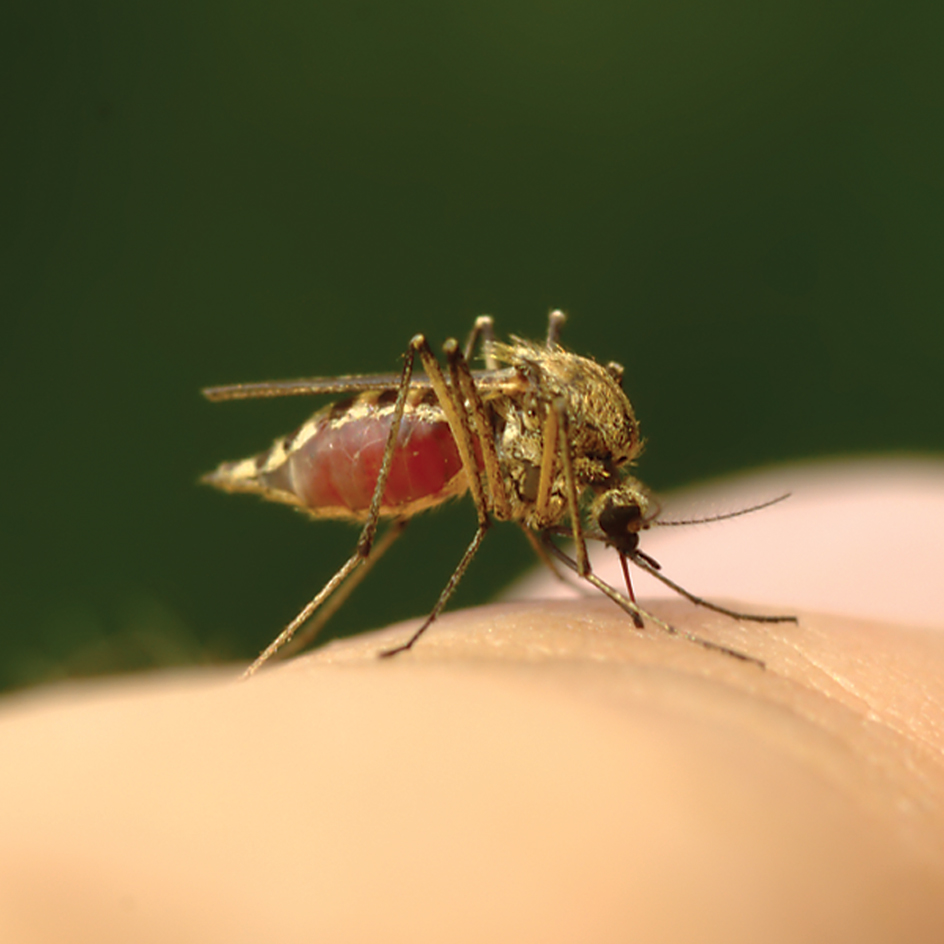
More than 3,000 species (kinds) of mosquitoes live worldwide, even in the Arctic. Biologists classify them into about 35 groups, each called a genus. For example, the common house mosquito belongs to genus Culex, and the Asian tiger mosquito belongs to genus Aedes.
Most mosquito species grow about 1/4 inch (6 millimeters) long. One of the largest is the gallinipper. It grows about 1/2 inch (13 millimeters) long.
The hum of a mosquito is the sound of its wings beating. A mosquito’s wings move about 1,000 times a second. A female’s wings make a higher tone than a male’s wings, and the sound helps males find mates.
The body of a mosquito
The mosquito’s slender body has three parts: (1) the head, (2) the thorax, and (3) the abdomen. The insect’s body wall is thin and elastic. Its body and wings have thin scales and fine, threadlike structures called hair. Mosquito hair is not true hair, which grows only on mammals, but it resembles true hair. Most kinds of mosquitoes are black, brown, gray, or tan. Many species have white or light-colored markings on their backs, legs, or wings. A few kinds are bright blue or green, and seem to shine with coppery or golden lights.
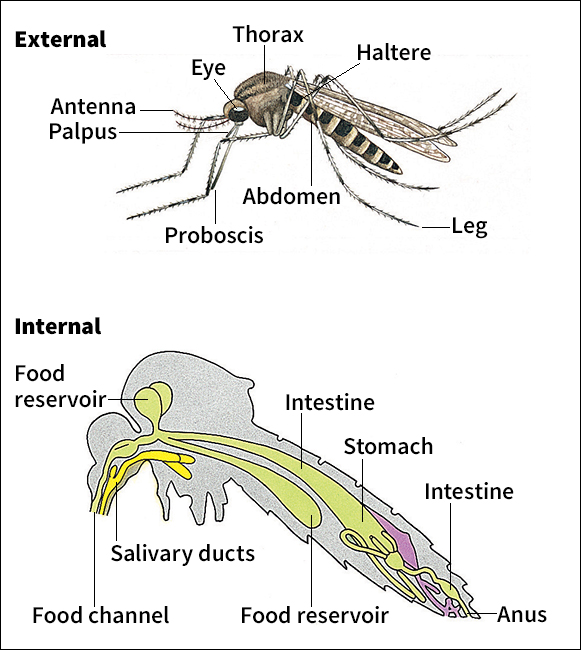
Head.
The mosquito has a large, round head that is joined to the thorax by a short, thin neck. Two huge compound eyes cover most of the head. These eyes, like those of most other insects, consist of thousands of six-sided lenses. Each lens points in a slightly different direction and works independently. A mosquito cannot focus its eyes for sharp vision, but it quickly sees any movement. The eyes are always open, even when the insect rests.
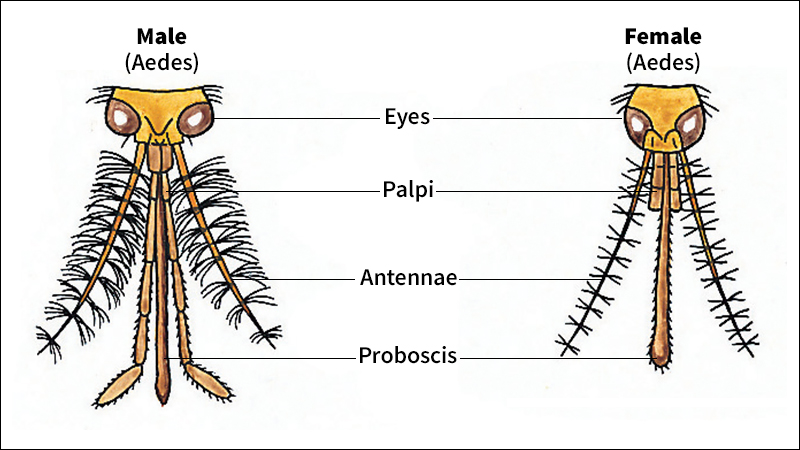
A mosquito hears and smells with its two long antennae, which grow near the center of its head between the eyes. The antennae of a female mosquito have a covering of soft hair. The male’s antennae possess bushy hairs that give them a feathery appearance.
The mouth of a mosquito looks somewhat like a funnel. The broadest part is nearest the head, and a tubelike part called the proboscis extends downward. A mosquito uses its proboscis to “bite,” and as a straw to sip liquids, its only food. The males and females of many species sip plant juices.
How a mosquito “bites.”
Only female mosquitoes “bite,” and only the females of a few species attack human beings and other animals. They sip the victim’s blood, which they need for the development of the eggs inside their bodies.
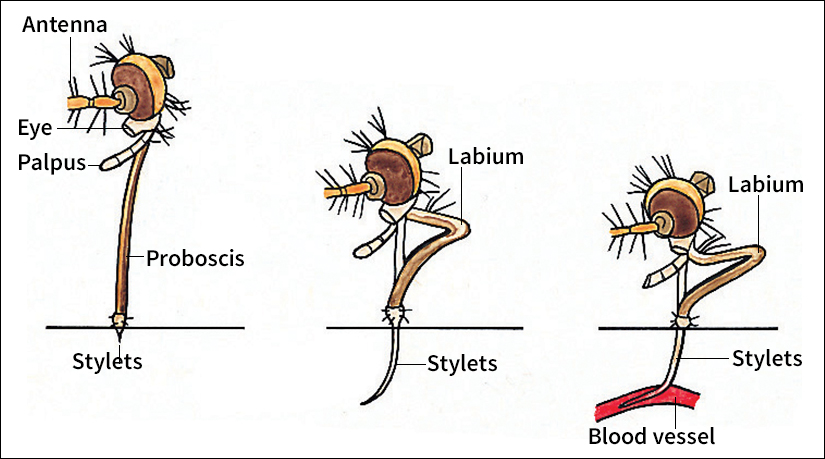
Mosquitoes do not really bite because they lack jaws. When a mosquito “bites,” it stabs through the victim’s skin with six needlelike parts called stylets, which form the center of the proboscis. The stylets are covered and protected by the insect’s lower lip, called the labium. As the stylets enter the skin, the labium bends and slides upward out of the way. Then saliva flows into the wound through channels formed by the stylets. The mosquito’s saliva keeps the blood from clotting, making it easier to sip. Most people are allergic to the saliva, and an itchy welt called a “mosquito bite” forms on the skin. After the mosquito has sipped enough blood, it slowly pulls the stylets from the wound, and the labium slips into place over them. Then the insect flies away.
The amount of blood taken varies greatly among individual mosquitoes. Some may consume more than their own weight from a single “bite.”
Thorax.
The mosquito’s thorax has a somewhat triangular shape, with the broadest part above and the narrowest part underneath. Thin, flat scales of various colors form patterns on the upper part of the thorax of certain kinds of mosquitoes. These patterns help identify different species. One kind of mosquito that spreads yellow fever has a U-shaped pattern formed by white scales on a background of dark scales.
Strong muscles are attached to the inside wall of the thorax. These muscles move the mosquito’s legs and wings. A mosquito has six long, slender legs, and each leg has five major joints. A pair of claws on each leg helps the insect cling to such flat surfaces as walls and ceilings. The mosquito uses all its legs when it walks, but usually stands on only four of them. Many kinds of mosquitoes rest on their four front legs. Some kinds hold their two hind legs almost straight out behind them, but others curve their legs over their back. White scales form bands on the legs of some species.
Mosquitoes have two wings, unlike most other kinds of insects, which have four. The wings are so thin that the veins show through. The veins not only carry blood to the wings, but also help stiffen and support them. Thin scales cover the veins and the wing edges. The scales rub off like dust when touched. Some species of mosquitoes may have scales of beautiful colors.
Instead of hind wings, which most other insects have, a mosquito has two thick, rodlike parts with knobs at the tips. These parts, called halteres, give the mosquito its sense of balance. The halteres move in a wide arc and can vibrate several hundred times in one second.
A mosquito lifts itself into the air as soon as it beats its wings. It does not have to run or jump to take off. In the air, the mosquito can dart quickly and easily in any direction. The halteres keep the insect in balance. A mosquito must beat its wings constantly while it is in the air. It does not glide during flight or when coming in for a landing as do butterflies, moths, and most other flying insects. A mosquito beats its wings until its feet touch a landing place.
Abdomen.
The mosquito’s long, slender abdomen looks somewhat like a tube. Some kinds of mosquitoes have an abdomen with a pointed end. Other kinds have an abdomen with a rounded end. The shape of the abdomen helps scientists identify the species.
A mosquito breathes through air holes called spiracles along the sides of its body. The abdomen has eight pairs of spiracles, and the thorax has two pairs. Air flows into the holes, and tubes carry the air from the spiracles to all parts of the mosquito’s body.
The life of a mosquito
A mosquito’s life consists of four stages: (1) egg, (2) larva, (3) pupa, and (4) adult. At each stage, the mosquito’s appearance changes completely, and the insect lives a different kind of life. In warm climates, some species develop from newly hatched eggs into adults in only a week. In the cold climate of the far north, mosquito eggs may remain dormant from autumn until late spring. They hatch in May or June, and may take a month or more to mature.
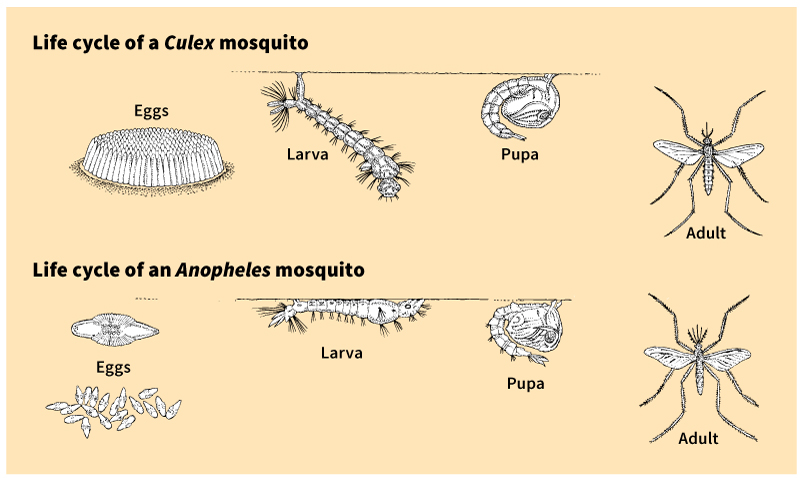
Egg.
A female mosquito lays from 50 to 200 eggs at a time, depending on the species. One female may lay as many as 1,000 eggs in her lifetime. She lays the eggs through an opening at the tip of her abdomen. The females of most species of mosquitoes lay their eggs in water or near it, but each species has a favorite spot. Some like quiet swamps, and others prefer salt marshes. Still others lay their eggs in such places as tin cans, rain barrels, gutters, rocks, or hollow tree stumps. These places will fill with water and form small pools.
Among some species, the females drop their eggs one at a time. Frilly, transparent parts on the shell keep each egg afloat until it hatches. Females of other species arrange their eggs in clusters that look somewhat like rafts. The female rests on the surface of the water while laying her eggs, which are narrow at the top. With her hind legs, she carefully pushes the eggs, wide ends downward, into a floating pad. The eggs of most kinds of mosquitoes hatch in two or three days in warm weather.
All mosquito eggs must have moisture to hatch, but not all species lay their eggs in water. Certain mosquitoes, called floodwater mosquitoes, drop their eggs in moist soil on flood plains and on irrigation sites. The eggs hatch after a flood takes place—perhaps a year later. Some African species lay their eggs in grassy, hollow places called dambos, which are left by ponds that have dried up. The eggs hatch after rains fill the ponds with water. Not all of the eggs of these mosquitoes hatch after the first rain. They must be soaked by a second or even a third rain before they hatch into larvae.
Larva.
A mosquito larva is often called a wriggler because it is so active. The wrigglers of most species move about by jerking their bodies through the water.
A wriggler looks somewhat like a worm or a caterpillar. A thin, skinlike shell covers its body. The wriggler has a broad head with two short, bushy antennae on each side. It has two eyes behind the antennae, near the back of the head. Its mouth is on the underside of the head, near the front. Long hairs called mouth brushes grow around the jaws and sweep food into the wriggler’s mouth. Unlike an adult mosquito, a wriggler can open its jaws and chew food. It eats tiny aquatic life, including bacteria, algae, and one-celled organisms called protozoans. The larvae of some species may eat other wrigglers.
A wriggler breathes through a tubelike siphon (air tube) at the rear of its body. To get air, it pushes its siphon above the surface of the water.
The larvae of certain swamp mosquitoes need not come to the surface for air. They get air from the leaves, stems, and roots of various underwater plants. These larvae have a breathing tube with two sharp tips. A larva uses one tip to hold itself to the plant, and moves the other tip back and forth in the plant tissue to get the oxygen stored there.
The larvae of many species of mosquitoes grow quickly. They molt (shed their skins and grow new ones) four times in 4 to 10 days. After the last molt, the larvae change into pupae. The larvae of some species hibernate in winter. They change into pupae early in spring.
Pupa.
A mosquito pupa is shaped somewhat like a comma. The head and thorax are rolled into a ball, and the abdomen hangs down like a curved tail. A thin “skin,” like that of the larva, covers the pupa’s body. An air space on each side of the body makes the pupa lighter than water. The pupa breathes through a pair of trumpet-shaped tubes attached to the top of its thorax. It sticks these tubes out of the water to get air. The pupa of certain swamp mosquitoes, whose larva gets air from underwater plants, pushes its tubes into the plant. After this pupa has changed into an adult, it pulls out the tubes and then swims to the surface.
The pupae of most species of insects do not move, but almost all kinds of mosquito pupae can swim. These pupae are sometimes called tumblers because they roll and tumble in the water.
A mosquito pupa does not eat. It changes into an adult in two to four days. The pupal “skin” splits down the back, and the adult mosquito pushes its head and front legs out and then pulls out the rest of its body.
Adult.
After the adult mosquito leaves the pupal “skin,” its wings dry quickly and it flies a short distance away. Most species of mosquitoes spend their whole lives within 1 mile (1.6 kilometers) of the place where they hatched. A few kinds may travel as far as 20 miles (32 kilometers) away to find food or mates.
A female mosquito attracts a mate by the high-pitched sound made by her wings. The males are deaf for the first 24 to 48 hours of their lives, until the hairs on their antennae fully develop.
The females of most species must sip blood before they can lay eggs that will hatch. Each species of female prefers the blood of certain kinds of animals. Some feed only on frogs, snakes, or other cold-blooded animals. Other mosquitoes prefer birds. Still other mosquitoes suck the blood of cows, horses, and people.
Male mosquitoes may live only about 7 to 10 days, but females survive 30 days or more. The females of some species live through the winter in barns, garages, houses, caves, or hollow trees. Some species spend the winter as eggs or as larvae. They then mature in the spring.
Mosquitoes and people
Mosquitoes spread germs and parasites that cause some of the world’s deadliest diseases. For example, the common house mosquito transmits a filaria (parasitic worm) that causes the skin disease elephantiasis. This mosquito also transmits such viruses as the Saint Louis encephalitis virus and the West Nile virus, both of which attack the brain. Mosquitoes become infected with the viruses when they feed on infected birds. They then carry the diseases to human beings and other animals.
Some mosquitoes in the genus Anopheles transmit malaria. This disease is a serious problem in the tropics and subtropics, where it kills hundreds of thousands of people each year.
Loading the player...Malaria growth
Several mosquitoes in the genus Aedes live throughout the world. One of them, the yellow fever mosquito, carries the yellow fever virus, which most commonly attacks people in Africa and South America. This mosquito and the Asian tiger mosquito also carry dengue viruses. Dengue disease occurs widely in Asia, Africa, and Central and South America. Aedes mosquitoes also carry the Zika virus, which has been linked to birth defects in people. The Zika virus has spread from Africa to Asia and the Americas.
People control mosquitoes in many ways. Small amounts of chemical insecticides kill adult mosquitoes when sprayed in homes, garages, and other buildings. Mosquito-control agencies may spray thin mists of insecticides into fields, forests, and gardens when the threat of disease becomes high. But the best traditional approach involves destroying the places where mosquitoes breed. Mosquitoes lay their eggs in marshes, swamps, and pools of still water, as well as in tree holes, discarded tires and containers, and yard and garden ornaments that contain standing water. Such objects and places may be drained, filled in, or covered with thin layers of oil or insecticides. 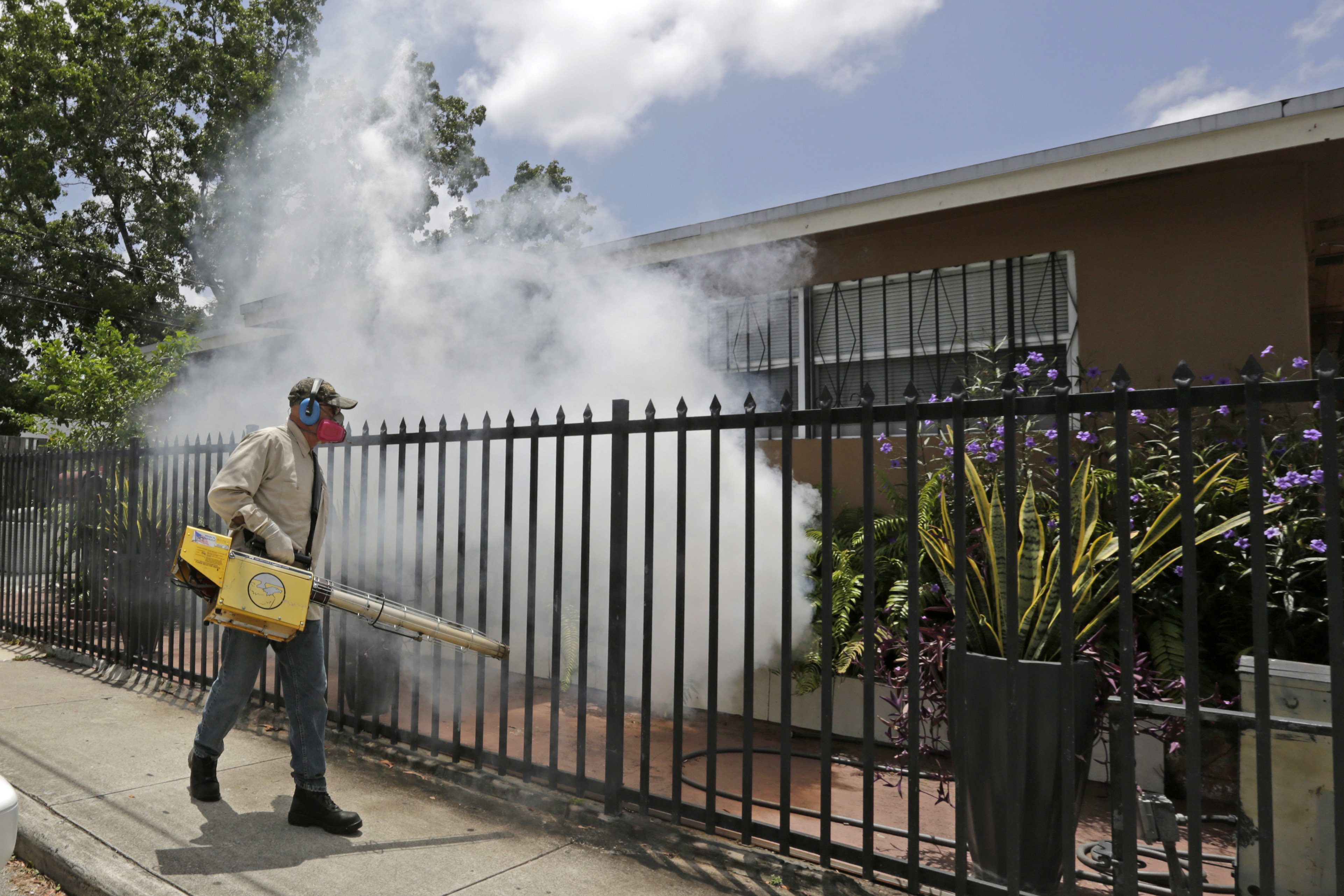
Since the 1960’s, scientists have turned increasing attention to the biological control of mosquitoes. These programs attempt to control the populations of certain species without damaging other parts of the environment. One program uses fish that eat mosquito larvae. Another uses the spores of a bacterium, Bacillus thuringiensis, to kill the larvae.
In addition, biologists are studying the genes (units of heredity) of Anopheles mosquitoes that spread malaria. These insects have proved difficult to control using traditional methods. Scientists hope current research may one day enable them to alter the mosquitoes’ genetic makeup so the insects can no longer transmit malaria-causing parasites.
